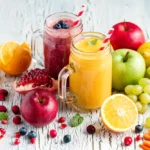Bubble tea has captivated taste buds worldwide, thanks to its endless customization options and unique add-ons that make every sip special. Boba vs popping boba are both highly sought-after toppings, but what sets them apart?
Both are visually irresistible, but they offer completely distinct experiences. Traditional boba delivers a satisfyingly chewy texture while popping boba surprises with flavorful juice.
Whether you’re a seasoned bubble tea enthusiast or just curious about these tasty toppings, this guide will help you decide. Get ready to explore the world of boba’s chewy charm and popping boba’s playful burst. Which one will win your heart? Let’s dive in!
What is Boba and How is it Made?
Boba, also known as tapioca pearls, is a beloved topping that originated in Taiwan during the 1980s and has become a global favorite, particularly in bubble tea.
How It’s Made
Ingredients: Boba is primarily made from tapioca starch, which is derived from the cassava root. This starch gives the pearls their signature chewy texture.
Process: The tapioca starch is combined with water to create a dough-like mixture. This dough is then kneaded and shaped into small spheres to form the boba pearls. Cooking: The pearls are boiled until they achieve the signature chewy, dense texture that makes them enjoyable.
Flavoring: After boiling, the cooked pearls are often soaked in sugar syrup to add a touch of sweetness and enhance their flavor.
The result is a chewy, slightly sweet add-on that pairs perfectly with milk or fruit teas turning each sip into a fun and satisfying experience.
What is Popping Boba and How is it Made?
Popping Boba offers a unique and lively twist on classic tapioca pearls. Its colorful and succulent spheres boast a delicate seaweed coating, containing a burst of flavor that erupts in your mouth for an unforgettable taste experience.
How It’s Made
Ingredients: The key ingredients for making popping boba are fruit juice, sodium alginate, and calcium chloride. Sodium alginate is a natural substance derived from seaweed that helps create the gel-like texture of the outer shell.
Process (Spherification): Sodium alginate mixed with fruit juice is dropped into a calcium chloride bath, forming a solid outer layer while keeping the inside liquid.
The result is a small, juice-filled sphere with a gel exterior that bursts when bitten. Available in flavors like mango, strawberry, and lychee, popping boba brings a burst of sweetness and excitement to bubble tea, making it a favorite for fruity drink lovers.
Flavor and Texture Comparison between Boba and Popping Boba
Boba (Tapioca Pearls)
Texture: Boba has a chewy and dense texture that provides a satisfying and comforting mouthfeel. The dense pearls create a steady, slow-paced experience as you sip.
Flavor: The flavor is mildly sweet, making it a perfect complement to creamy milk teas. Its subtle sweetness doesn’t overpower the drink, allowing the tea to shine while enhancing the overall flavor.
Popping Boba
Texture: Popping boba is encased in a thin, gel-like membrane that bursts with a playful and refreshing sensation. The outer shell adds a new layer of texture, making each bite an interactive experience.
Flavor: Popping boba is packed with bold, fruity flavors such as passionfruit, mango, and lychee. These flavors add a vibrant twist to your drink creating an exciting contrast to the more traditional bubble tea experience.
Your choice depends on whether you prefer a traditional bubble tea experience with a comforting texture (boba) or an adventurous twist with bold flavors (popping boba)!
The Experience: Drinking Boba vs Popping Boba Boba (Tapioca Pearls)
A Journey of Chewy Comfort: Boba offers a satisfying, chewy texture that complements the tea’s smoothness. The soft, gummy pearls are perfect for those who enjoy a drink that invites slow sipping.
Gentle Sweetness: Each bite of boba brings a gentle burst of sweetness, which pairs well with the tea’s flavor, providing a comforting balance of taste and texture. It’s familiar and satisfying, offering consistency with every sip.
Classic and Reliable: If you enjoy the classic bubble tea experience boba provides a steady and predictable texture. It’s ideal for those who like their drinks to feel grounded and traditional, creating a cozy, nostalgic experience.
Popping Boba
A Fun Twist: Incorporating popping boba into bubble tea infuses a burst of flavor and adds a playful contrast to its chewy texture. These juicy spheres burst with every bite, creating an exciting experience for the taste buds.
Excitement and Spontaneity: The sensation of each sphere popping with fruity juice turns your bubble tea into an interactive, adventurous experience. It adds fun and unpredictability to each sip, making it perfect for those who like a more exciting, lively drink.
Vibrancy: Popping boba is visually and experientially vibrant, with each flavor offering a new burst of fruity joy, whether it’s mango, strawberry, or passionfruit. This makes it ideal for people who love variety and surprises in their beverages.
The choice depends on whether you’re in the mood for comforting tradition or exciting bursts of flavor!
Which One is Healthier?
Boba (Tapioca Pearls)
- Made from tapioca starch, which is high in carbohydrates and makes it calorie-dense.
- Sweetened with natural sweeteners to enhance flavor, consequently increasing the overall caloric content.
- Typically chewy with a satisfying texture, making it a popular topping for milk and fruit teas.
Popping Boba:
- Made from flavored juice or syrup encased in a gel-like membrane, lower in carbs compared to tapioca pearls.
- Containing fewer calories than boba, but with added sugars that vary depending on the flavor (such as mango, lychee, and strawberry).
- The burst of fruity flavor when bitten adds a playful twist to your drink.
The overall health impact depends on factors like portion size, the type of tea, and any additional sweeteners or toppings. Moderation is key to making bubble tea a healthier treat!
Recipes Featuring Boba and Popping Boba
Boba Smoothie: Blend fresh fruits like mango or strawberry with yogurt and milk. Add cooked boba for a chewy surprise in every sip.
Popping Boba Ice Cream Sundae: Top vanilla ice cream with chocolate syrup and a variety of popping boba flavors for a fruity playful dessert.
Bubble Tea Cocktails: Combine brewed tea with spirits like rum or vodka, then mix in boba and popping boba for a fun, layered drink experience.
Fruit Salad with a Twist: Enhance diced fruits with cooked boba and popping boba for a unique combination of textures and fruity bursts.
These recipes are perfect for parties or personal treats, offering creative ways to enjoy the fun textures and flavors of boba and popping boba!
Conclusion: Which One Reigns Supreme?
Boba and popping boba each bring a unique appeal to bubble tea. Traditional boba offers a chewy texture and absorbs flavors, perfect for those who enjoy a classic experience. Popping boba, on the other hand, delivers an exciting burst of flavor that adds a playful twist to any drink. The choice comes down to personal preference: a comforting chew or a fun, juicy pop. Both toppings enhance your bubble tea in different ways, depending on what you’re craving at the moment. There’s no clear winner—just the joy of discovering which one suits your taste best!








